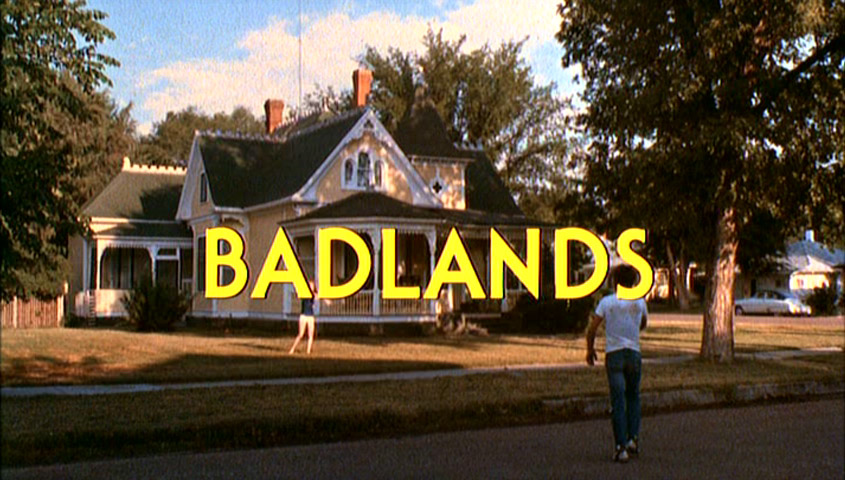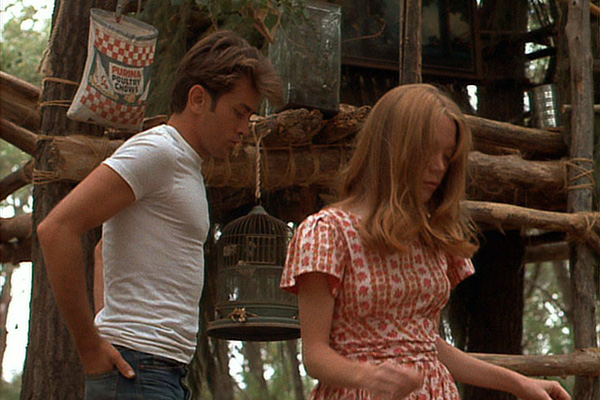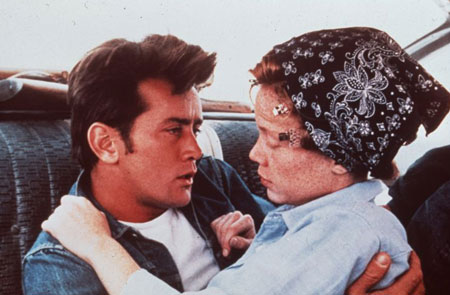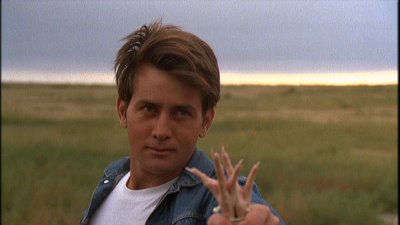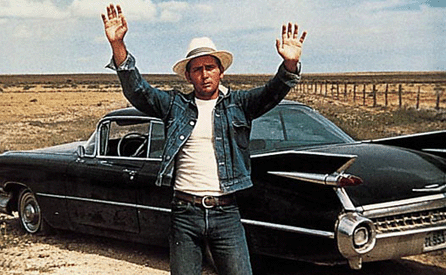This appeared in the November 1974 issue of Monthly Film Bulletin. The ironic aftermath of the final sentence in my review is that another five years would pass before the release of Malick’s second feature, and then 20 more before the release of his third. — J.R.
Badlands
U.S.A., 1973 Director: Terrence Malick
It would hardly be an exaggeration to call the first half of Badlands a revelation -– one of the best literate examples of narrated American cinema since the early days of Welles and Polonsky. Compositions, actors, and lines interlock and click into place with irreducible economy and unerring precision, carrying us along before we have time to catch our breaths. It is probably not accidental than an early camera set-up of Kit on his garbage route recalls the framing of a neighborhood street that introduced us to the social world of Rebel Without a Cause: the doomed romanticism courted by Kit and dispassionately recounted by Holly immediately evokes the Fifties world of Nicholas Ray -– and more particularly, certain Ray-influenced (and narrated) works of Godard, like Pierrot le fou and Bande à part. Terrence Malick’s eye, narrative sense, and handling of affectless violence are all recognizably Godardian, but they flourish in a context more easily identified with Ray. Unmistakably Malick’s own, however, is the narration and dialogue: like the movie’s violence, it remains laconic, idiomatic, detached, and chillingly real throughout, whether it’s reflecting on the visual action, enriching it, compressing it, or sharply deviating from it (as when Holly narrates her uncertainty about whether Kit’s capture was deliberate –- in the past tense -– while we’re shown that it is). Less sustaining, alas, is the sense of discovery illuminating the film’s first part: the further that the couple proceed in their travels, the more familiar and twice-told their story seems to become, grasping after sociological observations that were interesting when they figured in Gun Crazy, Bonnie and Clyde, The Honeymoon Killers, Targets, et al., but are uncomfortably close to platitudes in 1974. The stylistic familiarities, on the other hand, appear too quickly and variously for them to fall into predictable patterns. Holly occupying a bed with an enormous dog; her disappointment with her first foray into sex, and Kit picking up a stone to commemorate the event (substituting a smaller one when he finds it too heavy); a balloon carrying souvenirs sent off for posterity; Holly’s father painting a primitive landscape on a billboard in the middle of a primitive landscape; the integration of Holly’s greenish dress with the blue hallway in her house; the lyrical interlude (worthy of Fahrenheit 451) of fire consuming the house, “distanced” by the use of silence and [Carl Orff and Gunild Keetman’s] “Musica Poetica”; the fairy-tale ambience and irony of the forest sojourn, Kit reading National Geographic while Holly muses pantheistically on the soundtrack; her attempt at small talk about a pet spider with a dying Cato [Ramon Bieri]; sepia newsreel-like glimpses of police and frightened townsfolk: all these are too striking as images and as ideas, and too neatly abstracted out of their immediate contexts, to fit into traditional genre expectations. But evidence of Kit’s cheerful craziness -– delivering homespun advice about education into the rich man’s dictaphone, shooting a football that becomes “excess baggage” en route to Montana –- appearing at first to be refreshingly non-psychological in implication, start to set up an inevitability of their own, suggesting both psychology and contrivance once they start to accumulate. As the landscape grows wider, and the literal and figurative notion of a destination for the couple grows increasingly remote, the story-line shrinks and stiffens, as though returning to its journalistic origins. (According to William Johnson, the plot is based on the exploits of Charles Starkweather and Caril Fugate across the Dakota badlands in 1958.) Carrying Kit to the airport, one of the deputies remarks to the other: “I’ll kiss your ass if he don’t look like James Dean”. The line, inflection, and the expression on the officer’s face are perfectly rendered, but we recall that Holly has already made this comparison (not to mention Malick himself, in an image echoing Giant), and sense the pressure of a director striving too forcibly to impose a point. Similar strictures apply to the repeated use of a Satie piece and Kit’s flamboyant farewell to his “fans” at the airport. But a long time will have to pass before one forgets the words, gestures, and faces of Martin Sheen and Sissy Spacek — and hopefully a short one before the arrival of Terrence Malick’s second feature.
JONATHAN ROSENBAUM
—Monthly Film Bulletin, November 1974, vol. 41, no. 490

